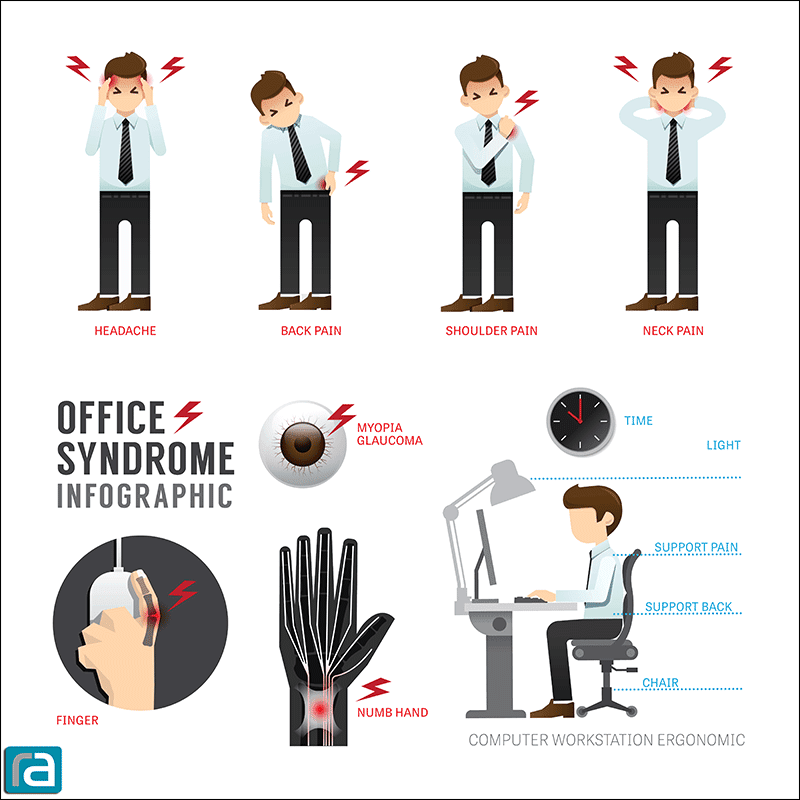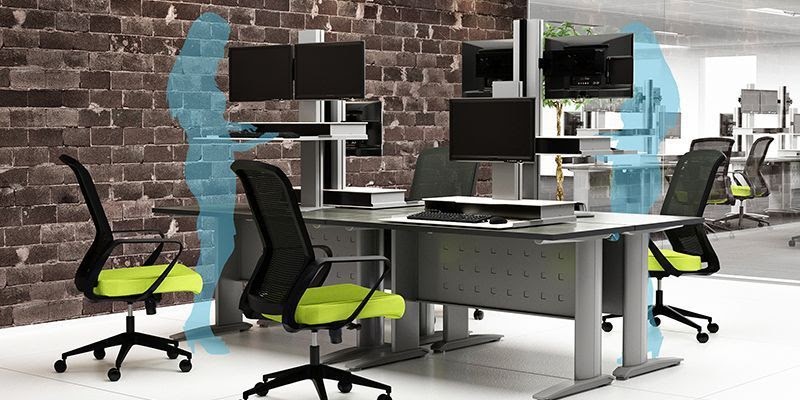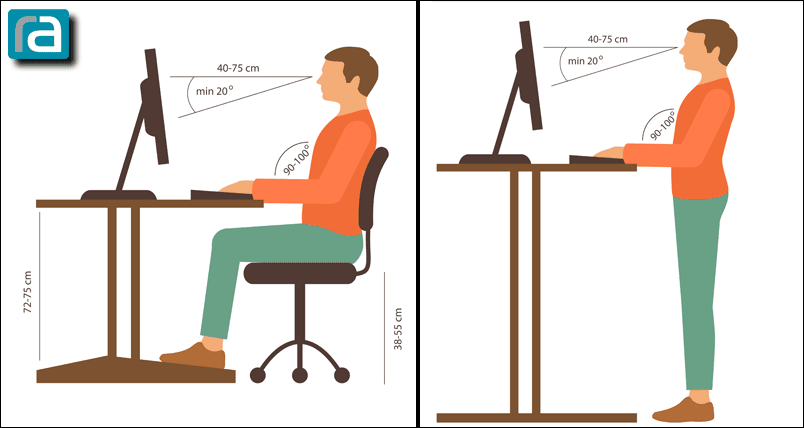At work, when people start experiencing back, neck, or shoulder pain, they consider buying ergonomic furniture. Unfortunately, when they start feeling pain, it may be too late to quickly remedy damage caused by using unsupportive furniture. Since ergonomic furniture helps relieve stiffness and pain, why not be proactive and nip the problem in the bud?
Research shows that three out of ten people spend their workday sitting at a desk using poor posture. Because they spend the day sitting so much, that poor position leads to back and neck pain. In fact, OSHA reports that one-third of the money spent on worker’s compensation claims are the result of insufficient ergonomic protection. Also, according to the Journal of American Medical Association, neck, and lower back pain costs $88 billion every year.
Ergonomics
Obviously, there is a lot of money spent dealing with pain that is preventable.
Poor posture doesn’t affect your health just in a single day. Sitting that way over the course of many weeks or years, however, is another story. Slouching at the desk may lead to a spine injury.

There is a proactive way to prevent such injuries: ergonomics. Ergonomic workstations are one way to avoid bad habits from turning into serious health issues.
Ergonomics is defined as an applied science concerned with designing and arranging things people use so that the people and things interact most efficiently and safely.
Not just a word, ergonomics is a culture. Development of an ergonomic culture requires thought and planning. In this article, we explore several facets of ergonomics you may not have thought of. Also, we offer several solutions to help you plan your ergonomic culture.
The first piece of the ergonomic puzzle is furniture, and we start with something you use for most of your workday: the chair.
Ergonomic Chairs
You might be taking your chair at work for granted. You sit on a chair for hours each day not knowing if the chair is the reason behind your back pain.
If you decide that you need a new chair, before spending your money, consider these four things.
Avoid Bargain Basement Pricing
Just because you find an incredible deal for an ergonomic chair doesn’t mean you should buy it. Companies that make cheap office furniture cut corners on cost by using poor material during their manufacturing process. Usually, these inexpensive pieces of furniture quickly fall apart.
Unless you plan on buying office furniture every few years, don’t buy any furniture made up of plywood or weak plastic. Spend a little more money buying from reputable dealers. Your office furniture looks better and lasts longer.
Lumbar Support
The ergonomic chair is one of the most popular ergonomic furniture items because they improve posture and reduce back pain of the person sitting on it. Before deciding to buy an ergonomic chair, you should ensure it provides enough support for your lumbar region.
An excellent ergonomic chair has a great lumbar support that protects your lower back. The chair should also have high-quality neck and head support to help maintain proper posture while supporting your legs enough to prevent issues with your knees.
Seat Depth
The more times a portion of an object touches the ground, the more stable it becomes. For example, a table with four legs is more stable than one with three. The same holds true for chairs.
How many times each day do you recline back to rest your neck or back? Odds are you do it without even thinking about it. Chairs using a five-point base are very stable, which reduce the chance of accidentally tipping over backward.
Seat depth is also necessary for the knees. Sitting for a long time puts pressure on your knees. The kneecap pushes the quadriceps tendon forward with enough force to crush your finger. Sitting with bent knees for long periods of time keeps the joint under constant pressure. This pressure strains the joint tissue leading to the development of pain over time.
Is it Adjustable?
Chair or desk, having the ability to adjust its height is important. Most of your employees are different sizes, so their chair needs are different, too. In addition to changing the height, the ability to adjust the backrest is essential for proper lumbar support.
Ergonomic Desks or Tables
There are several benefits of an adjustable, or sit stand, desk, some we’ve covered here.

Hover Helium Ergonomic Desk
Other benefits include:
- Burning Calories: the simple act of standing burn 50 more calories than while sitting. The more you move, the more calories you burn. A Mayo Clinic study showed a person burns 340 more calories each day by standing two hours instead of sitting.
- Reducing Chances for a Metabolic Syndrome: prolonged sitting may lead to metabolic syndrome — a cluster of conditions that includes increased blood pressure, high blood sugar, excess body fat around the waist and abnormal cholesterol levels.
- Better Posture: once your adjustable desk is correctly set up, slouching over your workstation is eliminated.
- Reducing Back Pain: a study by the CDC found that an adjustable desk neck and upper back pain by 54% after four weeks.
- Improves Mood and Energy Levels: In a seven-week study, people who used a standing desk reported less stress and fatigue than people who sat the entire day. Of those people who stood, 87% reported increased energy and vigor, too. Interestingly, that same study reported that when those people in the survey that stood returned to their old desk, their moods returned as well.
- Increased Productivity: If an employee doesn’t have to leave their workstation, they get more work done
The Ergonomic Concept Works
Ergonomics isn’t just related to the health of an employee. More companies that started an ergonomic culture into all facets of their organization are finding other benefits as well.

Some of Your Costs Go Down: as mentioned, one-third of worker’s compensation is attributed to poor ergonomics. Plus, indirect costs of poor ergonomics may add up to 20 times higher than a direct injury.
Quality Goes Up: lousy ergonomics creates workers who are fatigued and frustrated, so they’re not working at their best. If a task is too physical, an employee may not follow their training.
For example, an employee may not stack boxes correctly because they’re heavier than usual. In this case, not only is an inefficient use of space, unsteady boxes become a safety issue.
Greater Employee Engagement: if your company makes an effort ensuring the safety of your employees, they notice. If an employee isn’t tired or feeling uncomfortable during the day, turnover and absenteeism go down while morale and employee participation goes up.
Your Safety Culture Improves: creating an ergonomic program displays your company’s commitment to making health and safety a core value.
When you add these benefits up, your culture of safety grows and become stronger. Employees are your most valuable resource. Promoting a culture of safety results in improved employee performance.
Up to this point, we’ve discussed what ergonomics is and why it’s important. Let’s step away from desks and chairs to explore other ergonomic solutions.
The Principle of Office Ergonomics
The number of office workers suffering from fatigue, numbness, or tingling in the arms, hands, and wrists has increased dramatically with evolving computer technology. Proper keyboard height, palm supports, mouse location, feet, and knee positioning all play a part in minimizing these symptoms.

Studies have shown that keeping the wrists in a neutral position help relieve symptoms of carpal tunnel syndrome, RSI, and other wrist-related injuries.
Follow these guidelines to maximize the potential of your ergonomic keyboard.
- For maximum comfort, position the height of the keyboard so arms are relaxed and elbows rest easily at sides.
- Place your wrists in a neutral position.
- Use padded palm supports and a properly positioned mouse pad to minimize wrist and shoulder stress.
- Slightly elevate your knees above the seat pan and place your feet securely on the floor or a footrest.
If you sit in a locked position for an extended period, fatigue or stiffness sets in. Change your position frequently. Whether it’s standing up or stretching, the activity recharges your body.
Less Common Ergonomic Solutions
Become More Active
Consider the definition of ergonomics, designing and arranging things people use so that the people work safer and more efficient. Apply that definition to yourself.
Start taking microbrakes. Microbreaks are regular, short, biologically meaningful breaks from being stuck in one position for a while. Even a 30-second microbrake increases productivity up to 13%. A 15-second respite from staring at your monitor every 10 minutes reduces your fatigue by 50%.
There is an infographic at the end of this article created by OnlineBusinessDegree.org that illustrates the importance of taking brief breaks during the workday. The effectiveness of these short breaks is astounding.

Select Quality Footwear
Employers taking steps to improve ergonomics for their employees may see any possible benefit undone by poor shoes.
If you’re trying to find the cause of pain, try switching the style of shoes you wear. When you wear a shoe with an elevated heel, it causes your body to adapt to a new condition adding stress.
Picking your shoes follows the same thought process of choosing an office chair. My dad used to say, “you buy cheap, you get cheap.” The cost upfront might sting your pocketbook, but quality shoes last a lot longer than the discount pairs.
When shopping for proper footwear make sure the shoes:
- Make sure they have a minimal heel or are flat
- Look for a cushioned insole with arch support
- Have good traction
- Fit!
Keep an Eye on Your Eyes
German poet Johann Wolfgang von Goethe once wrote about overcoming obstacles, “the hardest thing to see is what is in front of your eyes.” Taking that quote further, if your eyeglass prescription is out of date, not only won’t you see what’s before you, but you may feel the pulse of a tension headache.
Get your eyes checked annually and work with an optometrist for other ideas about how to eliminate eye strain.

Remove the Phone from Your Neck
If your job requires you to be on the phone a lot (about an hour per day qualifies as “a lot”), ask your boss for a headset. A headset eliminates the need of pinching the receiver between the ear and shoulder, which leaves a painful kink in the neck.
In Sum
Frequently changing positions during the day helps break the habit of a sedentary day. Start things off slowly and be patient. Alternate sitting between and standing every two hours for two weeks to see how you feel.
Ergonomics isn’t just a catchphrase to use to impress people. It’s a proven method to increase the well-being of your staff, increase productivity, improve morale, and benefit your bottom line.
Infographic
The Importance of Breaks At Work
Writing at Lifehack, Jill Harness stresses the importance of taking a break at work.
Break laws aren’t just there to make employers take it easy on their workers, they are there for the good of employees. Did you know even a 30-second micro-break can increase your productivity up to 13%? Or that a 15-second break from staring at your computer screen every ten minutes can reduce your fatigue 50%?
If you’re one of those people who refuses to take breaks throughout the day because you don’t want to lose productivity, perhaps this infographic can change your mind by showing that not taking breaks will actually make you far less productive. Click for Full Size



COMMENTS